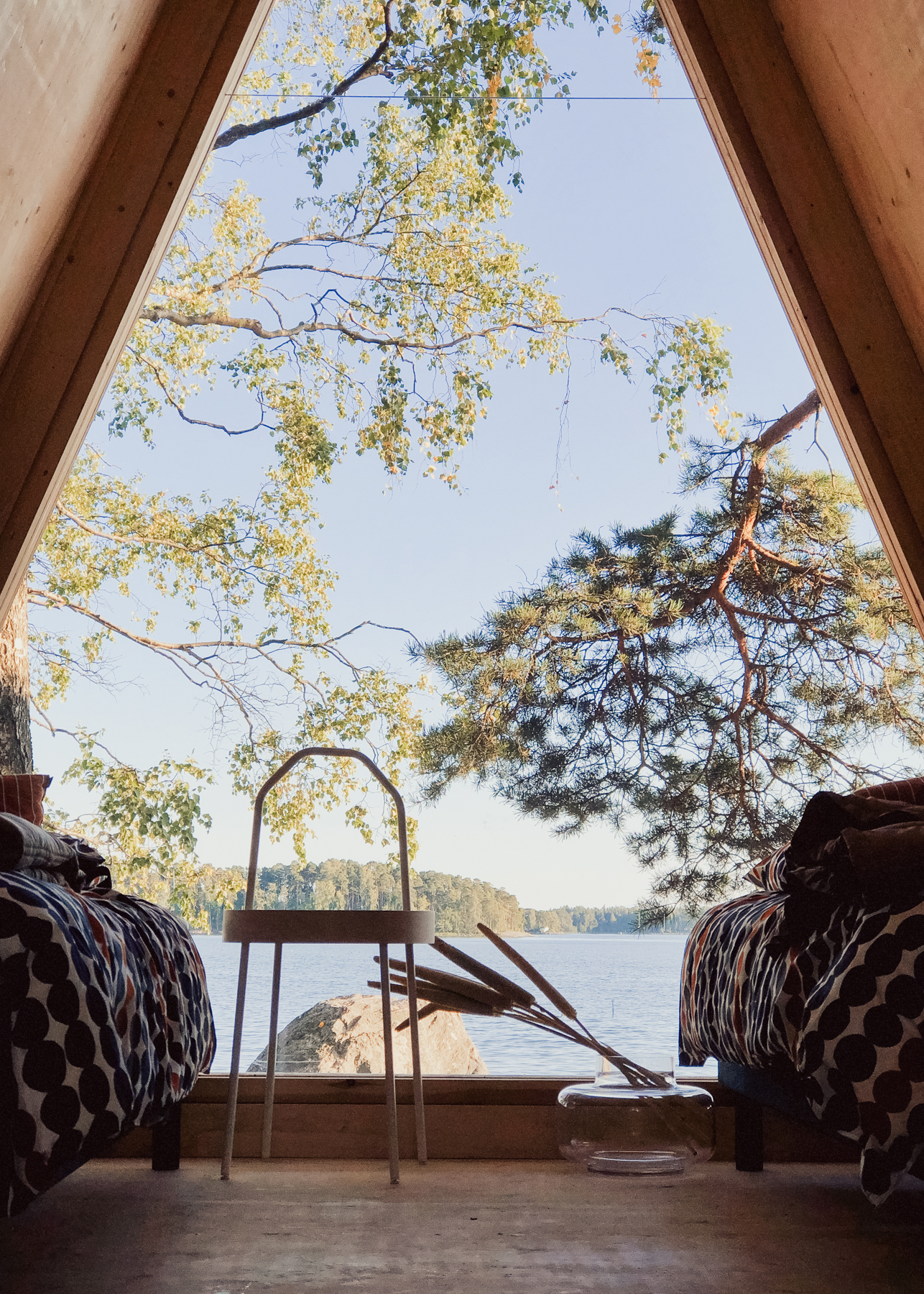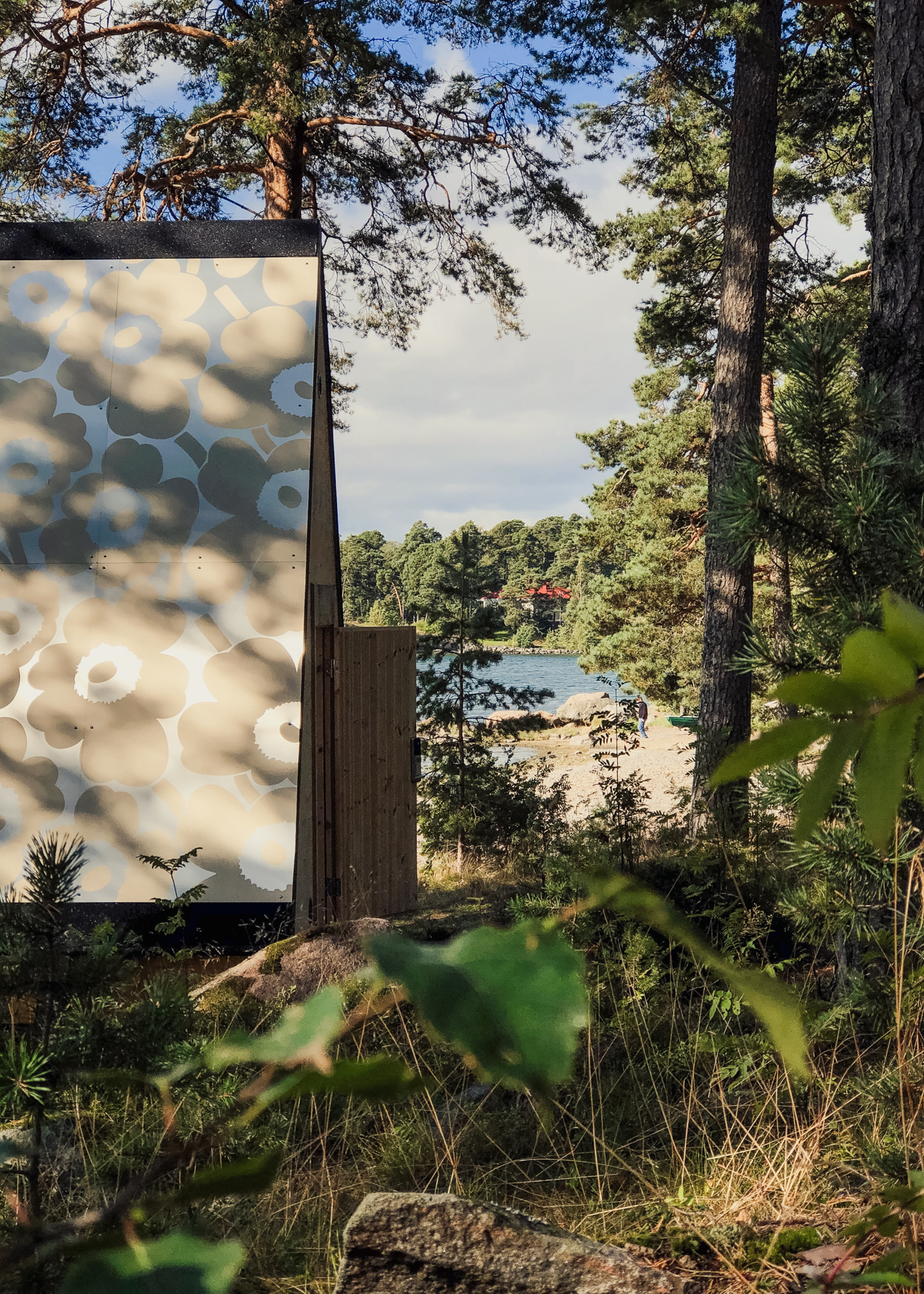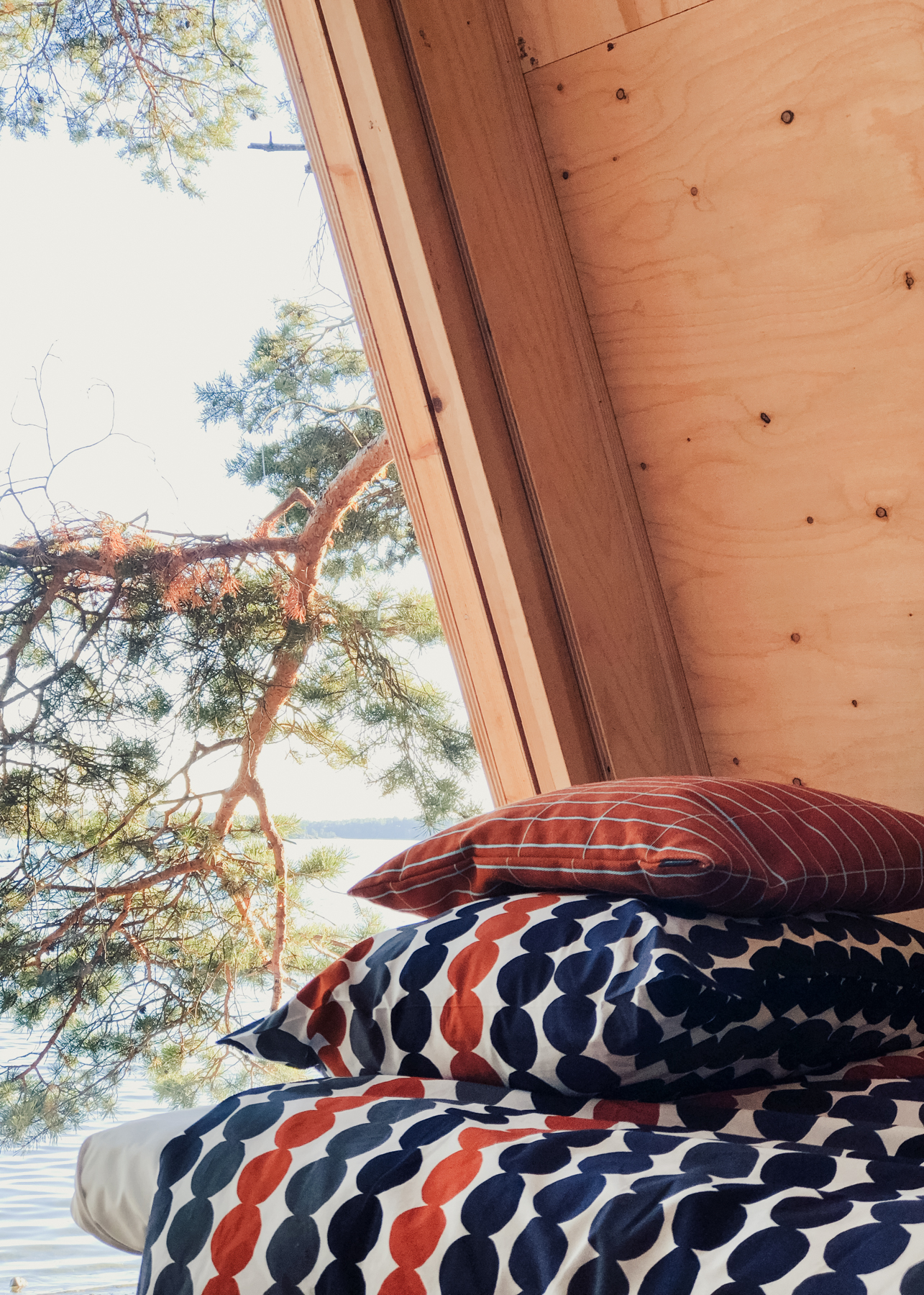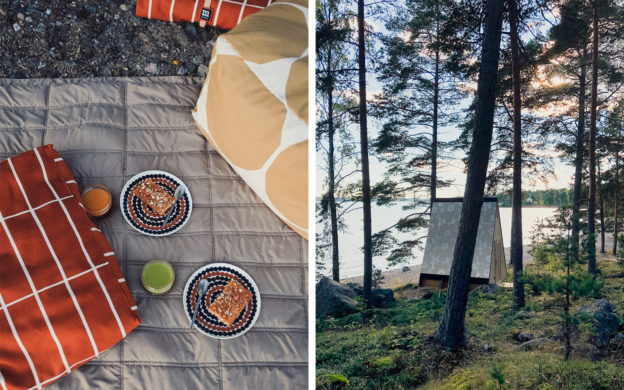If you’re looking to go camping in Finland, a stay at the Nolla Cabin is for you.
Slow cottage life has long been the essence of Scandinavian-style vacationing. Designer Robin Falck has envisioned and engineered an alternative to the typical Scandinavian summerhouse way of life. His eco-friendly designs serve both locals and travellers who seek peaceful city breaks close to nature.
Situated along coastal Helsinki and its archipelago, in close proximity to the city’s services, Falck’s Nolla Cabins are accessible and self-sufficient, with incredible views guaranteed.”
|
|
The construct is simple: an A-frame plywood roof, clear plexiglass wall, and wooden pedestals to support the cabin’s assembly on any terrain. It is easy to take apart and put together, so it can be moved quickly. The space is 10 square meters and is suitable for one or two people.
With very little building material, Falck has crafted a modern hideout, a grown-up version of a blanket fort, blending in with the mindfully-chosen surroundings. His design guidelines? Sustainability, quality, and context.
Although the cabin and the landscape around it will certainly look good on your camera roll, Falck wants to offer visitors some quality time away from their screens. With less distractions, the cabin retreat becomes an escapist experience.
 |
 |
For tenants who worry about having nothing to do, fear not. The closeness of nature is sure to offer entertainment. Five minutes after settling in the cabin, you might find yourself engaged in bird watching or berry-picking in your new backyard. The setup represents both an easy way of camping within the city lines, and some exposure to outdoor living, as there is no shower or toilet.
|
|
Some of the cabins are erected on rocks to face the Baltic Sea, some nestled alongside pine trees a couple feet above moss carpet.
One is set on the premises of seaside resort Hotelli Rantapuisto and is decorated with iconic Finnish design products: Marimekko textiles, furniture, and tableware.
All Nolla Cabins have a decor that is typically Scandinavian with minimalist lines, raw finishes and muted colors.
 |
 |
We spoke with Nolla Cabin designer Robin Falck about the project and how best to use the space:
What does Scandinavian design mean to you?
To me, Scandinavian style means simple form, multifunctionality, and down-to-earth design. With its non-luxurious approach to vacationing, Nolla Cabin embodies Nordic humbleness.
It is the cabin’s adaptability and aesthetics that I think will resonate with people most.
Tell us about your background and career journey.
I studied industrial design at Aalto University. Graphics and unpredictable combinations fascinated me. I started my career working at a design agency, but moved on as a freelance-designer soon after. I wanted to develop my conceptual thinking and nurture ideas of my own.
My “break” came with Nolla Cabin, a project first piloted and launched as part of a collaboration between myself and the Finnish energy company Neste. The company wanted to do something fresh while raising awareness of their use of renewable energy.
The Finns love spending time in rental and private cabins in natural settings. It is important to focus on not only the environmental impact of urbanism, but also the ecological footprint of Finnish summerhouse living.
The idea behind Nolla Cabin was to see what happens if a cabin is stripped down to the bare necessities, both in terms of facilities and the use of energy. Would people still find cabin-life relaxing? Could people, in fact, relax even better without TV and other gadgets?
The other pressing thing, besides environmental awareness, is that the traditional cabin living has become less popular among the new generations. In times of uncertainty, young adults want to invest in experiences instead of material things. Family summer houses are actually a lot of work: even before maintenance and renovation, they require readiness to pay inheritance tax if they are passed down.
When it comes to Scandinavian style-log lodges, there is a shift from owning to leasing property. With the staycation trend and booming domestic tourism, the short-distance solutions for getaways in nature are becoming more popular, to the point where we see best rental cabins fully booked season after season.
 |
 |
Finland is known for timeless design but also for timely innovations. As an entrepreneur, how do you view the national innovation potential?
The Finnish start-up scene is having a moment. I find myself having a symbiotic relationship with the local start-up ecosystem. The growth-oriented, entrepreneurial mindset fuels innovation – innovations which I’m hired to realize in the most functional and sustainable way possible. This was also the case with Neste, who commissioned the first Nolla Cabin.
In the innovation continuum, and in my profession in general, the key issue is to develop products that have a long life cycle. Even if someone else gives birth to the idea, my job is to make sure the end product has a happy life.
You are not only planning the physical structures but all services around the Nolla Cabins. What guides your design decisions?
For me, good design equals usability and customer-friendliness. When designing the functions, it is important to listen to both the industry voices and the desires of the public.
My goal is not to satisfy consumptions needs; it’s actually the opposite. I believe a well-designed service favors communal use in opposition to owning. In that sense, I practice service design.
I aspire to create effortless and accessible concepts that strike a balance between high quality and low threshold. With Nolla Cabin, I wanted to make sure there is no elitism.
I also wanted to ensure the path to purchase was easy. Booking is available on Airbnb and the check-ins are handled at a hotel or campsite reception. All of the cabins can be reached by public transport, whether it be a bus or a ferry. Some locations offer restaurant services and activities, such as canoeing, for Nolla Cabin visitors.
Safety and hygiene are key factors as well. Safe hiking paths lead to the cabins and the doors have electronic locks with individual codes. Professional cleaning service is part of the nightly fee, and the chosen organic materials are naturally antibacterial.
 |
 |
Your cabins can accommodate only two people at a time, unlike many family-suited holiday rentals. They provide the intimacy of small quarters, but also the vast natural surroundings. What is the experience like at Nolla Cabin?
The concept is scalable, but standards come before volume. The starting point of my work is a sense of freedom, which is why I chose modular design: it brings flexibility. The cabin can be modified to better fit visitor needs. Parts can be added, removed, and customized as desired.
For the price per night, you get privacy of a wilderness hut, completed with the comfort of heating and electricity. The power plugs connect to the energy supply coming from the large solar panel sitting on the roof, while the heat comes from the little stove that utilises biofuel made from waste and residue. Due to the stove, the cabins can welcome visitors until the late fall. The experience changes according to the seasons, and no night is the same.
The typical customer would be a single traveler or a couple. The customer should prefer simplicity over a hectic holiday schedule. You can only bring the supplies you can fit into the tiny cabin. To reconnect with nature, you might bathe in the sea or hike in the forests. Instead of calling room service, you can make your own picnic-style breakfast and enjoy it on the beach rocks.
How can Nolla Cabin visitors interact with nature?
Nature is present not only around the cabin but inside it, too. The design follows nature’s terms. You can see the night sky from your bed and wake up to the birds singing in the morning.
One of the cabins is placed on the island of Utö. The island used to host a military base; nowadays serves as a home for some 40 year-round residents as well as great bird life. You can visit Utö’s old lighthouse and admire the rough sea.
Is the cabin suitable for all conditions? In Finland, the night temperatures can drop close to the freezing point even during the summer months.
Guests are encouraged to turn on the stove only if necessary, which rarely is the case. Even if the night is chilly, the bulky blankets provide warmth.
 |
 |
Nolla Cabin promotes a cyclic way of living. When and how does the circle close for Nolla Cabin?
Ideally, one cabin stays in one place for three to four years, after which the structure is removed and nature will carry on as before. The cabin is shaped like a hiking tent, and just like on a temporary camping trip, the cabin can be relocated without leaving a trace behind.
The goal is to respect the surroundings. Thanks to the pedestals, the cabin will not rest directly on the ground. This means that the weight placed on the soil is minimized, with close to zero signs of erosion. When disassembled, the cabin can be transported easily, without the moss or other vegetation suffering.
The more guests one cabin accommodates over time, the better it fulfills its purpose of efficient material use. In essence, Nolla Cabin is a mobile dwelling put together from surplus materials.
Without a concrete foundation or a fixed plot of land, the building materials can be dismantled and recycled at any point. Timber resists wear pretty well, so the duration of its life cycle is up to us.
Stay at the Nolla Cabin on Vallisaari.
Photos by John Saragosa. See more of his work here.
Heads up! This post contains affiliate links. The commission we earn when you buy through our links comes at no extra cost to you. For more information about affiliates, please see our Disclosure Policy.

